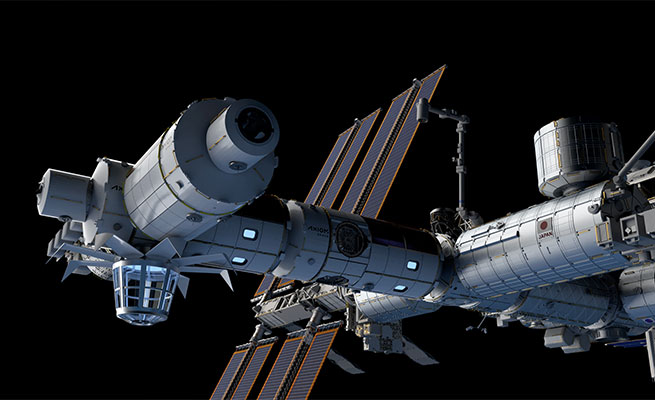Axiom Space: Space Station

Axiom Space, Inc., also known as Axiom, is an American privately funded space infrastructure developer head-quartered in Houston, Texas.
The company’s leadership team is largely composed of former NASA employees, including former NASA Administrator Charles Bolden. Other key people at the company include astronauts Michael Lopez-Alegria and Brent W. Jett Jr.
Axiom Space
Axiom Space simplifies access to the ISS for research and in-space manufacturing while constructing the world’s first commercial space station as a platform for a global user base.
For all users seeking to study and innovate on ISS, Axiom’s lower-cost, turnkey solution includes:
- Hardware development support including design, testing, and manufacturing of flight systems to support customer objectives
- Spacecraft payload integration and flight processing
- Mission development, planning, and execution services
- Business development support for growth of in-space industrial research and manufacturing use cases
- Unique research accommodations and services aboard Axiom’s private crew missions to the ISS
They intend to have its spacecraft modules individually launched and assembled in-orbit, first attaching to the International Space Station. Before ISS retirement (and atmospheric reentry), the company plans to detach its modules and commence orbit on its own as Axiom Station.
The company targets 2024 for its first module to attach to the ISS and the late-2020s for station completion.
The space station
Axiom plans to conduct astronaut training for commercial astronauts, to host governments and commercial partners, as well as private astronauts.
The interior for Axiom Station was designed in 2018 by French architect Philippe Starck. Renderings of the habitat show a chamber with walls that are covered with tufted padding and studded with hundreds of colour-changing LEDs. They have publicly stated an intent to maintain at least one astronaut in the station continuously. This astronaut will be assigned to take care of research projects and station repairs. This includes amenities like high-speed Wi-Fi, video screens, picture windows, and a glass-walled cupola.
Due for completion in the late-2020’s, the Axiom Space Station is set to be the first private space station of its kind. It will initially be attached to the International Space Station and assembled piece by piece in orbit before disconnecting from the ISS on its retirement.
The “egg-like” pods will offer unobstructed views of our earth, as you’ve never seen it before.
Axiom Space: Science in Space
Much like the International Space Station, the Axiom Station will act as a laboratory carrying out critical research, micro-gravity experimentation and technology demonstrations. Private astronauts travelling to the station will engage many activities.
Axiom have partnered with Space X to provide transportation to the station via the Dragon capsule and Falcon 9 launch rocket.
The Boeing Starliner crew capsules may also be utilised in the future for transporting commercial and private astronauts to the Axiom Station.
Axiom Orbital Segment
Axiom Orbital Segment or Axiom Segment (or AxS) are the planned modular components of the International Space Station (ISS). It was designed by Axiom Space for commercial space activities. Axiom Space gained initial NASA approval for the venture in January 2020.
Axiom Space Segment
At least four Axiom modules will attach to the International Space Station. The first module is planned to be launched in 2024 and would dock to the forward port of Harmony, requiring relocation of Pressurized Mating Adapter (PMA-2) to any other ports on ISS like Harmony nadir. It is planned to attach at least three additional modules to its first core module, and send private astronauts to inhabit the modules.
The company released preliminary plans in February 2020. They show how the Axiom Orbital Segment could form the basis for the Axiom Station. This includes a power and thermal module with an airlock. The company plans to launch its first module to the ISS in 2024, with the second, third and fourth launching in 2025, 2026 and 2027 respectively
Axiom Space Modules
AxH1
Axiom Station’s first planned module, Hab 1, is expected to launch in 2024. It will provide quarters for four crew members.
AxSEE-1
Axiom Space has planned to manufacture the SEE-1 module for Space Entertainment Enterprise (or S.E.E.). It will be the first entertainment studio in space. It is currently planned to launch in late 2024 after AxH1 has connected to the ISS.
AxH2
Axiom Station’s Hab 2 module is expected to launch in 2025. It will provide quarters for an additional four crew members allowing the station to support up to eight crew.
AxRM
Axiom Station’s research and manufacturing lab is planned to launch in 2026.
AxEO
Axiom Station’s Earth Observatory will be a glass-walled cupola planned to launch in 2026.
AxPT
Axiom Station’s Power Tower will provide power via solar array to support the station. This means that the Axiom Station will be able to support itself once it disconnects from the ISS. It is expected to launch in 2027. Until AxPT is launched, Axiom Station will be relying on the ISS to help provide power.
Assembly
There have been no announcements as to which rocket will carry the AxS modules into Low Earth orbit.
Purpose
Axiom Station is planned to have a lab module, AxRMF, to provide opportunities for Low Earth orbit research and manufacturing.




